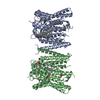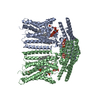[English] 日本語
 Yorodumi
Yorodumi- EMDB-47207: Structure of the phosphate exporter XPR1/SLC53A1, high Pi and Ins... -
+ Open data
Open data
- Basic information
Basic information
| Entry |  | |||||||||
|---|---|---|---|---|---|---|---|---|---|---|
| Title | Structure of the phosphate exporter XPR1/SLC53A1, high Pi and InsP6-bound | |||||||||
 Map data Map data | phosphate exporter XPR1/SLC53A1, high Pi and InsP6-bound | |||||||||
 Sample Sample |
| |||||||||
 Keywords Keywords | Inorganic phosphate exporter / TRANSPORT PROTEIN | |||||||||
| Biological species |  Homo sapiens (human) Homo sapiens (human) | |||||||||
| Method | single particle reconstruction / cryo EM / Resolution: 3.3 Å | |||||||||
 Authors Authors | Zhu Q / Diver MM | |||||||||
| Funding support |  United States, 1 items United States, 1 items
| |||||||||
 Citation Citation |  Journal: Nat Commun / Year: 2025 Journal: Nat Commun / Year: 2025Title: Transport and InsP gating mechanisms of the human inorganic phosphate exporter XPR1. Authors: Qinyu Zhu / Madeleine F Yaggi / Nikolaus Jork / Henning J Jessen / Melinda M Diver /   Abstract: Inorganic phosphate (Pi) has essential metabolic and structural roles in living organisms. The Pi exporter, XPR1/SLC53A1, is critical for cellular Pi homeostasis. When intercellular Pi is high, cells ...Inorganic phosphate (Pi) has essential metabolic and structural roles in living organisms. The Pi exporter, XPR1/SLC53A1, is critical for cellular Pi homeostasis. When intercellular Pi is high, cells accumulate inositol pyrophosphate (1,5-InsP), a signaling molecule required for XPR1 function. Inactivating XPR1 mutations lead to brain calcifications, causing neurological symptoms including movement disorders, psychosis, and dementia. Here, cryo-electron microscopy structures of dimeric XPR1 and functional characterization delineate the substrate translocation pathway and how InsP initiates Pi transport. Binding of InsP to XPR1, but not the related inositol polyphosphate InsP, rigidifies the intracellular SPX domains, with InsP bridging the dimers and SPX and transmembrane domains. Locked in this state, the C-terminal tail is sequestered, revealing the entrance to the transport pathway, thus explaining the obligate roles of the SPX domain and InsP. Together, these findings advance our understanding of XPR1 transport activity and expand opportunities for rationalizing disease mechanisms and therapeutic intervention. | |||||||||
| History |
|
- Structure visualization
Structure visualization
| Supplemental images |
|---|
- Downloads & links
Downloads & links
-EMDB archive
| Map data |  emd_47207.map.gz emd_47207.map.gz | 204.1 MB |  EMDB map data format EMDB map data format | |
|---|---|---|---|---|
| Header (meta data) |  emd-47207-v30.xml emd-47207-v30.xml emd-47207.xml emd-47207.xml | 12.6 KB 12.6 KB | Display Display |  EMDB header EMDB header |
| Images |  emd_47207.png emd_47207.png | 67.3 KB | ||
| Filedesc metadata |  emd-47207.cif.gz emd-47207.cif.gz | 4.4 KB | ||
| Others |  emd_47207_half_map_1.map.gz emd_47207_half_map_1.map.gz emd_47207_half_map_2.map.gz emd_47207_half_map_2.map.gz | 200.2 MB 200.2 MB | ||
| Archive directory |  http://ftp.pdbj.org/pub/emdb/structures/EMD-47207 http://ftp.pdbj.org/pub/emdb/structures/EMD-47207 ftp://ftp.pdbj.org/pub/emdb/structures/EMD-47207 ftp://ftp.pdbj.org/pub/emdb/structures/EMD-47207 | HTTPS FTP |
-Validation report
| Summary document |  emd_47207_validation.pdf.gz emd_47207_validation.pdf.gz | 915.3 KB | Display |  EMDB validaton report EMDB validaton report |
|---|---|---|---|---|
| Full document |  emd_47207_full_validation.pdf.gz emd_47207_full_validation.pdf.gz | 914.8 KB | Display | |
| Data in XML |  emd_47207_validation.xml.gz emd_47207_validation.xml.gz | 15.5 KB | Display | |
| Data in CIF |  emd_47207_validation.cif.gz emd_47207_validation.cif.gz | 18.5 KB | Display | |
| Arichive directory |  https://ftp.pdbj.org/pub/emdb/validation_reports/EMD-47207 https://ftp.pdbj.org/pub/emdb/validation_reports/EMD-47207 ftp://ftp.pdbj.org/pub/emdb/validation_reports/EMD-47207 ftp://ftp.pdbj.org/pub/emdb/validation_reports/EMD-47207 | HTTPS FTP |
-Related structure data
- Links
Links
| EMDB pages |  EMDB (EBI/PDBe) / EMDB (EBI/PDBe) /  EMDataResource EMDataResource |
|---|
- Map
Map
| File |  Download / File: emd_47207.map.gz / Format: CCP4 / Size: 216 MB / Type: IMAGE STORED AS FLOATING POINT NUMBER (4 BYTES) Download / File: emd_47207.map.gz / Format: CCP4 / Size: 216 MB / Type: IMAGE STORED AS FLOATING POINT NUMBER (4 BYTES) | ||||||||||||||||||||||||||||||||||||
|---|---|---|---|---|---|---|---|---|---|---|---|---|---|---|---|---|---|---|---|---|---|---|---|---|---|---|---|---|---|---|---|---|---|---|---|---|---|
| Annotation | phosphate exporter XPR1/SLC53A1, high Pi and InsP6-bound | ||||||||||||||||||||||||||||||||||||
| Projections & slices | Image control
Images are generated by Spider. | ||||||||||||||||||||||||||||||||||||
| Voxel size | X=Y=Z: 0.8255 Å | ||||||||||||||||||||||||||||||||||||
| Density |
| ||||||||||||||||||||||||||||||||||||
| Symmetry | Space group: 1 | ||||||||||||||||||||||||||||||||||||
| Details | EMDB XML:
|
-Supplemental data
-Half map: Half map A
| File | emd_47207_half_map_1.map | ||||||||||||
|---|---|---|---|---|---|---|---|---|---|---|---|---|---|
| Annotation | Half map A | ||||||||||||
| Projections & Slices |
| ||||||||||||
| Density Histograms |
-Half map: Half map B
| File | emd_47207_half_map_2.map | ||||||||||||
|---|---|---|---|---|---|---|---|---|---|---|---|---|---|
| Annotation | Half map B | ||||||||||||
| Projections & Slices |
| ||||||||||||
| Density Histograms |
- Sample components
Sample components
-Entire : XPR1/SLC53A1
| Entire | Name: XPR1/SLC53A1 |
|---|---|
| Components |
|
-Supramolecule #1: XPR1/SLC53A1
| Supramolecule | Name: XPR1/SLC53A1 / type: organelle_or_cellular_component / ID: 1 / Parent: 0 / Macromolecule list: all |
|---|---|
| Source (natural) | Organism:  Homo sapiens (human) Homo sapiens (human) |
-Macromolecule #1: XPR1/SLC53A1
| Macromolecule | Name: XPR1/SLC53A1 / type: protein_or_peptide / ID: 1 / Enantiomer: LEVO |
|---|---|
| Sequence | String: MKFAEHLSAH ITPEWRKQYI QYEAFKDMLY SAQDQAPSVE VTDEDTVKRY FAKFEEKFFQ TCEKELAKIN TFYSEKLAEA QRRFATLQNE LQSSLDAQKE STGVTTLRQR RKPVFHLSHE ERVQHRNIKD LKLAFSEFYL SLILLQNYQN LNFTGFRKIL KKHDKILETS ...String: MKFAEHLSAH ITPEWRKQYI QYEAFKDMLY SAQDQAPSVE VTDEDTVKRY FAKFEEKFFQ TCEKELAKIN TFYSEKLAEA QRRFATLQNE LQSSLDAQKE STGVTTLRQR RKPVFHLSHE ERVQHRNIKD LKLAFSEFYL SLILLQNYQN LNFTGFRKIL KKHDKILETS RGADWRVAHV EVAPFYTCKK INQLISETEA VVTNELEDGD RQKAMKRLRV PPLGAAQPAP AWTTFRVGLF CGIFIVLNIT LVLAAVFKLE TDRSIWPLIR IYRGGFLLIE FLFLLGINTY GWRQAGVNHV LIFELNPRSN LSHQHLFEIA GFLGILWCLS LLACFFAPIS VIPTYVYPLA LYGFMVFFLI NPTKTFYYKS RFWLLKLLFR VFTAPFHKVG FADFWLADQL NSLSVILMDL EYMICFYSLE LKWDESKGLL PNNSEESGIC HKYTYGVRAI VQCIPAWLRF IQCLRRYRDT KRAFPHLVNA GKYSTTFFMV TFAALYSTHK ERGHSDTMVF FYLWIVFYII SSCYTLIWDL KMDWGLFDKN AGENTFLREE IVYPQKAYYY CAIIEDVILR FAWTIQISIT STTLLPHSGD IIATVFAPLE VFRRFVWNFF RLENEHLNNC GEFRAVRDIS VAPLNADDQT LLEQMMDQDD GVRNRQKNRS WKYNQSISLR RPRLASQSKA RDTKVLIEDT DDEANT |
-Experimental details
-Structure determination
| Method | cryo EM |
|---|---|
 Processing Processing | single particle reconstruction |
| Aggregation state | particle |
- Sample preparation
Sample preparation
| Buffer | pH: 7.4 |
|---|---|
| Vitrification | Cryogen name: ETHANE |
- Electron microscopy
Electron microscopy
| Microscope | TFS KRIOS |
|---|---|
| Image recording | Film or detector model: GATAN K3 (6k x 4k) / Average electron dose: 66.0 e/Å2 |
| Electron beam | Acceleration voltage: 300 kV / Electron source:  FIELD EMISSION GUN FIELD EMISSION GUN |
| Electron optics | Illumination mode: FLOOD BEAM / Imaging mode: BRIGHT FIELD / Nominal defocus max: 1.7 µm / Nominal defocus min: 0.7000000000000001 µm |
| Experimental equipment |  Model: Titan Krios / Image courtesy: FEI Company |
- Image processing
Image processing
| Startup model | Type of model: NONE |
|---|---|
| Final reconstruction | Resolution.type: BY AUTHOR / Resolution: 3.3 Å / Resolution method: FSC 0.143 CUT-OFF / Number images used: 100408 |
| Initial angle assignment | Type: MAXIMUM LIKELIHOOD |
| Final angle assignment | Type: MAXIMUM LIKELIHOOD |
 Movie
Movie Controller
Controller

















 Z (Sec.)
Z (Sec.) Y (Row.)
Y (Row.) X (Col.)
X (Col.)




































